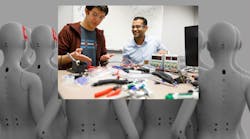In a TED Talk on the incredible potential of flexible, soft robots, Giada Gerboni asks audiences to consider the standard approach to robotic design—not the brain, but the rigid exoskeleton.
Robots have for many years been designed for speed and precision, which require a specific architecture, explained Gerboni, a biomedical engineer who was a postdoctoral fellow at Stanford University at the time. Every joint and every appendage needs to be accurately measured, as a small error can result in a fault or damage. “What makes a robot precise and strong also makes them ridiculously dangerous and ineffective in the real world,” she said before arguing for an alternative approach.
Soft robotics is paving the way for safer, more flexible applications, such as healthcare, where its shape-shifting properties can be used in surgical procedures, or industrial applications, where soft robotics are better suited to work safely alongside workers.
The global soft robotics market size is projected to reach 3.41 billion by 2027. It is touted for its ability to remove complexity of mechanical and algorithmic robot designs, and can increase flexibility and adaptability of the manufacturing process due to sensing capabilities.
Neither the economics nor the research in soft robotics is trivial. The Champlain Towers South tragedy in Surfside, Fla. led to difficult recovery efforts. Many wondered whether a quicker, safer way to search for survivors was possible.
One researcher, Isuru Godage, assistant professor in DePaul University’s College of Computing and Digital Media, is working precisely on finding a solution that can help first responders during a similar crisis. His solution involves the deployment of dozens of transformable, soft robots into any opening found around the perimeter of a collapsed building.
The adaptable robots could change into snake or legged robot forms, so they can navigate a staircase, small sewer line openings or a pool of water. These robots will safely alert first responders to survivors along their pathway and provide a blueprint for where rescue efforts should begin.
Godage, who was recently awarded a Faculty Early CAREER Development grant, focuses his research on ways to significantly advance the theory and practice of reconfigurable heterogeneous soft robots in the interconnected areas of design, fabrication, morphological optimization and intelligent control.
Soft Approach
Current robots usually fall into one of five categories: pre-programmed robots such as those found in assembly lines; humanoid robots that look like or mimic human behavior; autonomous robots such as Roombas; augmenting robots such as prosthetic limbs or exoskeletons; or teleoperated robots such as drones.
These robots have two limitations:
- They have a fixed configuration that cannot be altered once assembled; and
- Most robots that can be reconfigured for a variety of circumstances have been built with rigid materials and pneumatics. This makes them impractical for fieldwork, said Godage. Pneumatic robots need to be tethered to a compressor, for example, and he noted that the cord can be tangled and damaged easily.
To address these shortcomings, Godage will instead run robots on electromechanical design, allowing them to be portable and tetherless. In the beginning, humans would command the robots, but Godage’s holistic vision is to make his robots autonomous so they can decide what to do. This could be achieved by installing additional sensors, he said.
For the design, Godage is finding inspiration in the tail of nature’s spider monkey. The animal’s tail is made of an endoskeleton, surrounded by muscles that help it bend at any point and perform complex tasks, such as grasping tree limbs while swinging from trees.
“We would like for this robot to have a rigid skeleton on the inside, but the outside is made of soft materials such as silicone and rubber that can bend without buckling or crushing the internal components,” Godage said.
His research grant encompasses looking at ways to exploit the “hard/soft component interaction and constrained actuator arrangement to control stiffness independently from bending.” The project is developing a unified design and optimization framework to optimize hard/soft modules and to optimize sensor placement.
Godage has big plans for putting his robots in service, including planetary exploration or intelligence gathering.
“The Mars Rover vehicles are groundbreaking, but sometimes you need to search for life in really challenging areas—maybe in some liquid pools, caves or crevices,” he explained. “These robots would be perfect for that. Or they could also be used for reconnaissance. You could roll the robot into a ball and drop it to the ground to gather intelligence, without sending humans into potentially dangerous situations.”


